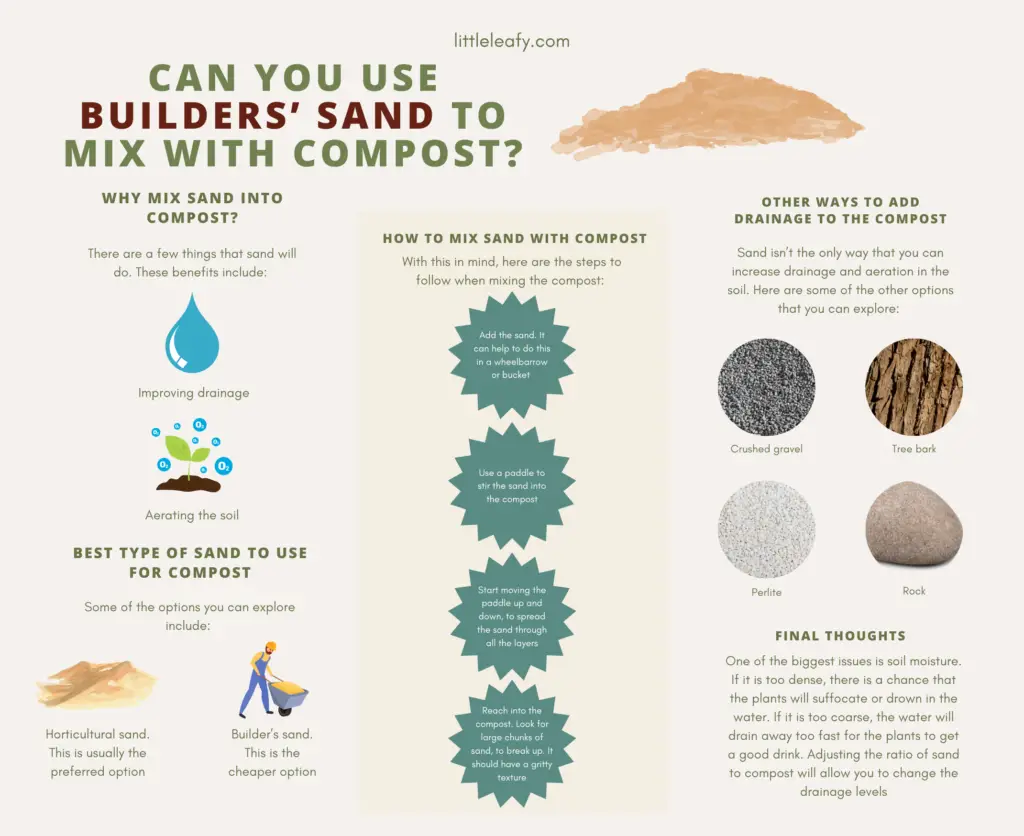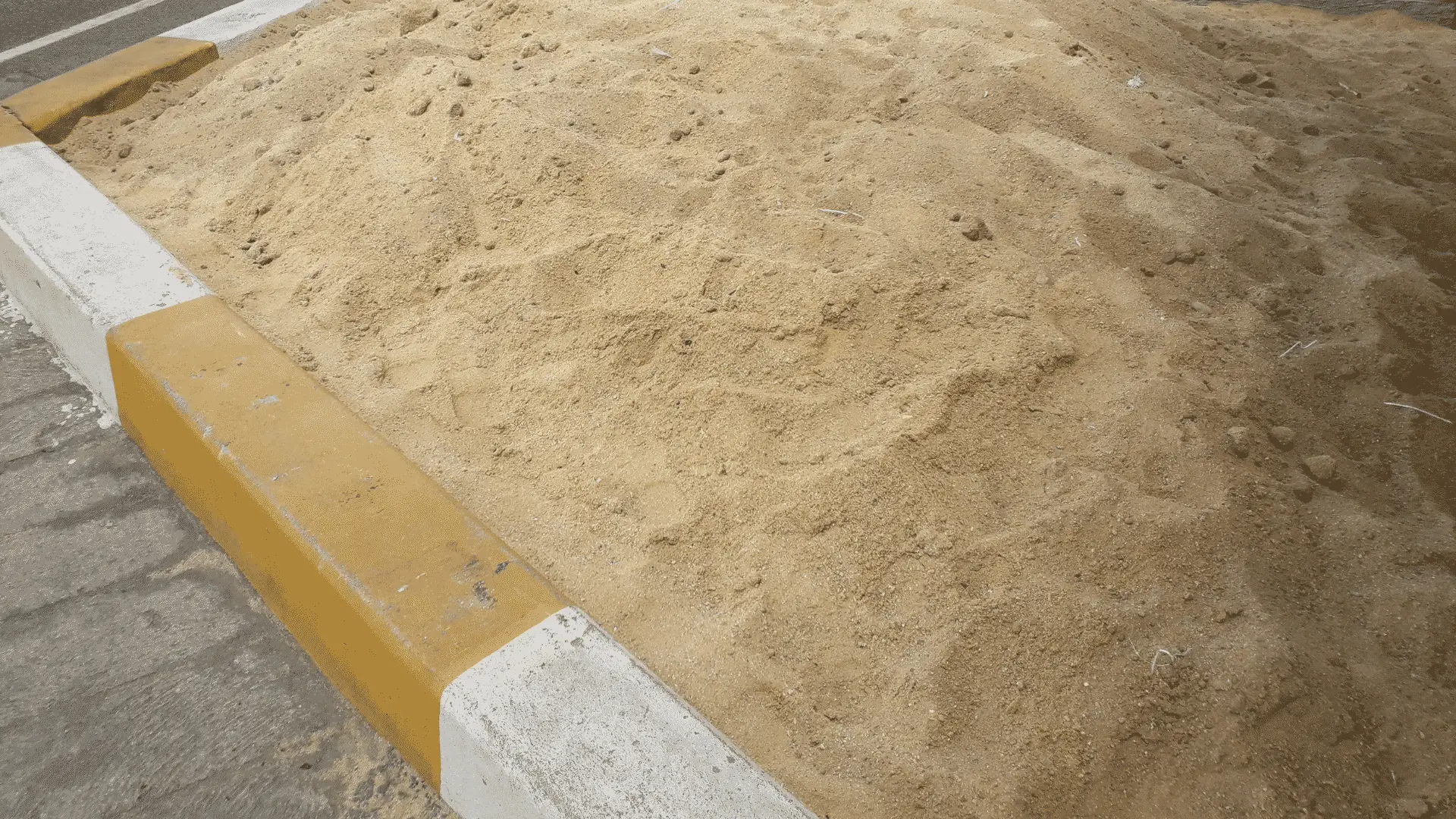Reading Time: 5 minutes 🍃
If you plan to make your own compost, you will often need to incorporate sand. But with so many types of sand available, it can be hard to know which one you should choose. So, will builder’s sand be a good choice for compost?
Builders’ sand will perform well when added to compost. It will aerate and improve drainage. You just need to ensure that you get coarse sand rather than fine variety. If the sand is too fine, it can increase soil compaction.
Sand is one of the most important parts of any compost mix. So, you want to make sure that you are using the right variety. Keep reading to learn about the options you can explore and which option is right for you.

Why Mix Sand Into Compost?
Let’s start by answering one of the most important questions. Why would you need to include sand in compost at all? There are a few things that sand will do. These benefits include:
- Improving drainage. Sometimes, your compost will be thick, retaining a lot of water. For some plants, this can cause issues, as they don’t their roots to get waterlogged. Sand will help create holes in the soil, so some of the excess moisture can drain away.
- Aerating the soil. Another problem with dense compost is the risk that it can make it harder for the roots to absorb oxygen. Without air, the plant won’t be able to grow.
It should be noted that you should only add sand to your compost. Don’t put it in native soil. If you do, there is a chance that you will end up increasing compaction, making the soil even harder to work with.
Furthermore, before you add sand to the soil, you should think about the type of plants you intend to grow. Some like looser soil with plenty of air pockets. Other species like denser soil, with lots of moisture. Adjust the mix accordingly.
Once you put in the compost, you should monitor for signs that the plants are getting too much or too little water. This will often be expressed in the color of the leaves. Not enough water and the leaves will start to turn yellow, or the edges will go brown, depending on the species.
Best Type of Sand to Use For Compost
There are a few types of sand you can use when creating compost. Each comes with its own set of pros and cons. Some of the options you can explore include:
- Horticultural sand. This is usually the preferred option. There are a few reasons why gardeners prefer to use this option. First, it has been tested and has a uniform pH level. It also has thicker grains, which are best for creating air pockets in the compost.
- Builder’s sand. The biggest downside to horticultural sand is the cost. If you are seeking a cheaper alternative, you might want to consider using builder’s sand. This is also a thicker grain. But it won’t have the same agricultural focus as horticultural sand. Just make sure that you get sand that is designed to be used for landscaping projects.
It should be noted that you don’t want to use play sand or a variety that is designed to be used to make sandpits. While these will be easy to find and fairly cheap, the particles are too fine. Because of this, they will suck the soil molecules closer, making the drainage and aeration issues even worse.
Sometimes, you might be thinking about using natural sand, like from a beach. Though this can seem like a good idea, it can cause a lot of headaches in the future. It often won’t have a consistent pH, and the mineral content will be similarly inconsistent.
Choosing a Sand
When faced with the prospect of choosing the right sand, it can often feel overwhelming. There are so many options for you to choose from. Thankfully, there are some easy ways for you to narrow down your choices and settle on the right choice; these are:
- pH level. When you add sand to the compost it has the potential to change the pH of the mixture. This can make it unsuitable for the target plant species. Horticultural sand should tell you the pH, so you can figure out what impact it will have. At other times, though, you will need to perform a pH test.
- Size of the grain. Avoid anything that is too fine. This will stick together once inside the compost, hardening the mixture and stopping water from penetrating properly.
If there is any sand left over, put it in a plastic container. You can then store it for future projects, including making plenty of compost.
How to Mix Sand With Compost
Before you start mixing the sand into the compost, it’s important to take a few safety precautions. Wear a mask. This will protect against the small dust particles that can be released when moving sand. This is especially important if you have asthma.
The ratio of sand to compost will shift depending on the type of plants you intend to use it for. It’s also important to consider how dense the compost is. In most cases, though, you will need to use a ratio of 10 to one for dense clay-like compost.
This is just a general guide designed to break up dense compost. The amount of sand you add should be determined by the type of plants you want to grow. It’s a good idea to do a little research to learn how much moisture they require in the soil.
With this in mind, here are the steps to follow when mixing the compost:
- Add the sand. It can help to do this in a wheelbarrow or bucket.
- Use a paddle to stir the sand into the compost.
- Start moving the paddle up and down to spread the sand through all the layers.
- Finish by using your hands to reach into the compost. You should be looking for large chunks of sand, which you can break up. It should have a gritty texture.
It’s a good idea to do a few final checks before you add the sand to your garden. For example, check the pH level and make sure that it’s a good fit for your plants.
Other Ways to Add Drainage to the Compost
Sand isn’t the only way that you can increase drainage and aeration in the soil. Here are some of the other options that you can explore:
- Crushed gravel
- Tree bark
- Perlite
- Rock
Which one you opt to use will depend on the type of compost you are making. For example, tree bark will break down over time, releasing nutrients into the soil. On the other hand, perlite doesn’t contain any nutrients and tends to be pH neutral.
Similar to mixing in the sand, you might need to use a 50-50 split. Stir it in, monitoring the way the soil composition changes. When it has a gritty feeling, the water will be able to drain away freely.
Final Thoughts
Getting the right type of compost is important; it will be setting up your plants for success. However, one of the biggest issues is soil moisture. If it is too dense, there is a chance that the plants will suffocate or drown in the water. If it is too coarse, the water will drain away too fast for the plants to get a good drink. Adjusting the ratio of sand to compost will allow you to change the drainage levels.
Sources
- https://www.gardenguides.com/98156-types-silt-clay-soil.html

- https://simplifygardening.com/add-sand-to-garden-soil/

- https://gardentipsforall.com/can-i-use-builders-sand-for-gardening/#:~:text=Yes%2C%20you%20can%20use%20builders,improve%20water%20movement%20and%20aeration

- https://www.gardeningknowhow.com/garden-how-to/soil-fertilizers/what-is-horticultural-sand.htm

- https://www.gardenguides.com/how_5664375_mix-sand-compost.html


